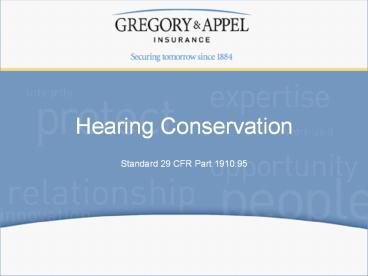Standard 29 CFR Part 1910.95 PowerPoint PPT Presentation
1 / 14
Title: Standard 29 CFR Part 1910.95
1
Standard 29 CFR Part 1910.95
Hearing Conservation
2
Agenda
- Today youll be learning about
- Hearing and Noise exposure
- Audiometric testing (hearing tests)
- Hearing protection (ear plugs, muffs, etc.)
- Hearing conservation training
3
Hearing Conservation What is it?
- Hearing Conservation is a company program that
- Establishes the noise levels present in various
areas of our facility - Outlines the steps required to protect employee
hearing in those areas.
4
How we hear
- Noise is a series of vibrations that travel
through the air as waves. The sound waves strike
our ear drum and cause it to vibrate, which in
turn causes the liquid within our inner ear to
vibrate. - Inside of our inner ear are hair-like projections
called cilia. Nerves are attached to the cilia,
and as they move with the liquid, nerve impulses
are transmitted to the brain. - Prolonged exposure to excessive noise causes the
cilia to fail and become unable to transmit sound
impulses. - Once the cilia fail from overexposure to noise,
we have lost our hearing. This is called
NOISE-INDUCED HEARING LOSS - Usually, surgery, hearing aids, etc. are of
limited use to correct noise-induced hearing
loss.
5
Noise
- Noise is unwanted sound
- Noise at or above 85 decibels (dB) for a long
duration can cause permanent loss to our hearing - Loss can also come from an impact noise of 140dB
or greater - Some noise comparisons are
- Normal conversation/office 60 decibels
- Busy traffic 75 decibels
- Woodshop noise 100 decibels
- Chainsaw 110 decibels
- We monitor noise in our facility Areas with
exposure at or above 85dBA are addressed in the
Hearing Conservation Program
6
Audiograms
- Audiograms are hearing tests. Sounds are
presented to you at the following frequencies,
measured in Hertz (cycles per second) - -500 -3000
- -1000 -4000
- -2000 -6000 The larger the number, the
higher the pitch of the sound
- Sounds are presented through ear phones while you
sit in a very quiet room or booth - You will be asked to respond by pushing a button
or by raising your hand
7
Audiogram results
- The results of your audiogram are recorded and
compared to your baseline audiogram - The baseline audiogram is the record of either
your first audiogram or of an audiogram where a
significant change in your hearing was noted - If your audiogram shows that your hearing has
worsened by an average of 10 dB or more in the
2000, 3000 or 4000 Hertz frequencies, you will be
told that you have a standard threshold shift, or
STS, and special procedures will be followed to
ensure that your hearing loss is stabilized.
8
Standard Threshold Shift (STS)
- If you have an STS, you may have suffered a
noise-induced hearing loss - Noise-induced hearing loss is usually a slow
developing process that is insidious, which
means that you do not recognize the loss because
it is so gradual it sneaks up on you. - The insidious nature of noise-induced hearing
loss is often the reason that employees fail to
follow the rules to prevent it They dont
realize that the noise exposure is hurting them
9
Signs of hearing loss
- Early signs of hearing loss
- -Conversations seem muffled
- -You increase TV and radio volume
- -You keep asking others to speak up
- Long-term effects of hearing loss
- -You cant engage in conversations with others
- -You are unable to enjoy TV, movies and other
entertainment - -You can become socially isolated
- Think of someone that you know who has
significant hearing loss
10
Preventing hearing loss
- The only way to prevent noise-induced hearing
loss is to wear hearing protection in areas with
noise exposure at or greater than 85dB - Areas in our facility where hearing protection is
required include areas we will discuss now - You must also wear hearing protection when you
are at home and engaging in activities with high
noise exposure such as - -Working with power tools
- -Working with small engine powered tools
- -Shooting
- Noise exposure at home will have the same effect
as noise exposure at work both can cause hearing
loss
11
Hearing protectors
- Hearing protectors are available at work and must
be worn when and where required - All hearing protectors are evaluated and approved
for use in our facility they work! - General rules for hearing protectors
- -Read and follow the package instructions
- -Be sure your hands are clean when handling ear
plugs - -Keep re-usable hearing protection clean and
store the equipment properly when not in use - Lets look at hearing protection that you will be
using
12
Training and information
- You will receive annual Hearing Conservation
training that includes rules for our facility,
available hearing protection and how to use it,
and other important information - You will receive an annual audiogram - if any
significant change is noted you will be notified
in writing - You have access to a copy of the OSHA standard
Occupational Noise Exposure. You can ask the
program administrator to see a copy. There is
also a copy posted in our facility
13
Conclusion
- Hearing loss can occur from excessive exposure to
loud noise at work and at home - Once noise-induced hearing loss has occurred,
medication, surgery and hearing aids are of
limited use for treatment - Noise-induced hearing loss can make it almost
impossible to communicate with others - Hearing loss can only be prevented by wearing
hearing protection at work and at home
14
For more information
- For more information regarding Hearing
Conservation, or other safety issues, please
contact - Gregory Appel Insurance
- Mike Salazar, Vice President
- Direct 317-686-6407
- Email msalazar_at_gregoryappel.com

